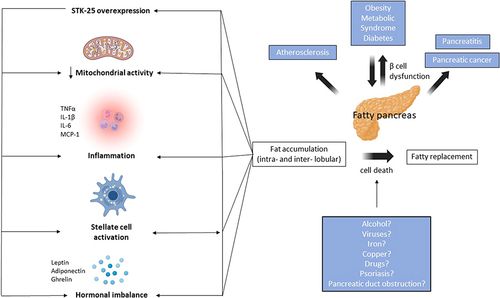Figures & data
Figure 1 Pathogenetic mechanisms behind fatty pancreas. The main pathogenetic mechanism behind non-alcoholic fatty pancreas diseases (NAFPD) is fatty accumulation (intra- or inter- lobular), followed by fatty replacement and, ultimately, β cell dysfunction. The main risk factors associated with NAFPD are obesity and metabolic syndrome (including dyslipidemia), while alcohol, viruses, iron deposition, drugs, gut hormones, psoriasis and pancreatic duct obstruction represent potential secondary;hits’ which participate in cell death and replacement of pancreatic tissue with fat. Mechanisms associated with fat accumulation include reduction in mitochondrial activity, inflammatory cell infiltration with production of inflammatory cytokines (eg TNFα, ΙL-1β, IL-6, MCP-1), activation of stellate cells, hormonal imbalance (with perturbed leptin and adiponectin levels), as well as STK-25 pathway overexpression, which further exacerbates all the aforementioned mechanisms. NAFPD, in turn, is associated with various conditions including diabetes, pancreatitis, pancreatic cancer, as well as atherosclerosis.

